8+ Sample Company Shareholders Agreement
-
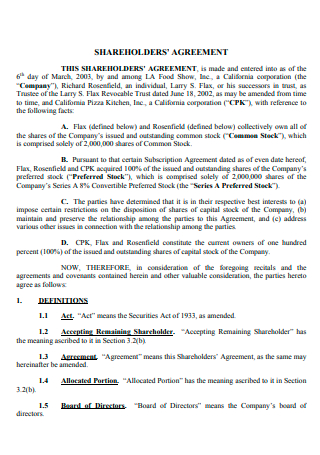
Company Shareholders Agreement Template
download now -
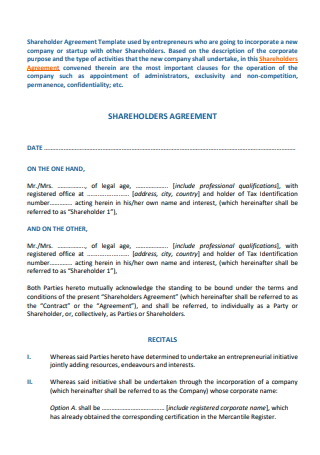
Basic Company Shareholders Agreement
download now -
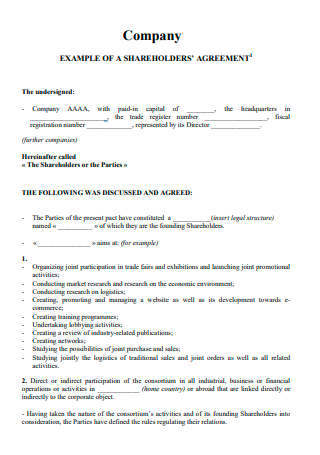
Company Shareholders Agreement Example
download now -
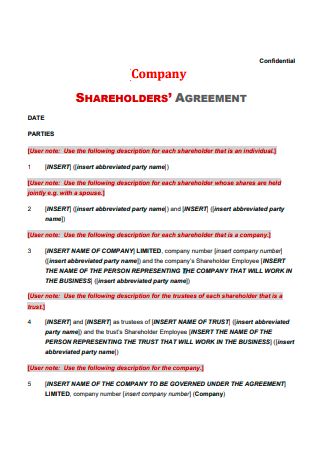
Confidential Company Shareholders Agreement
download now -
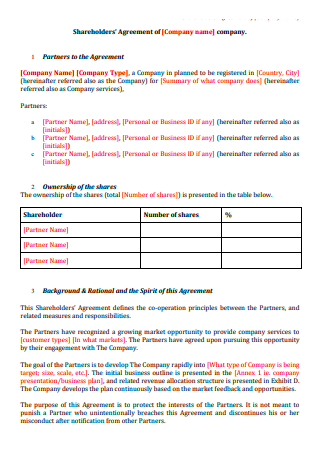
Company Shareholders Agreement in PDF
download now -
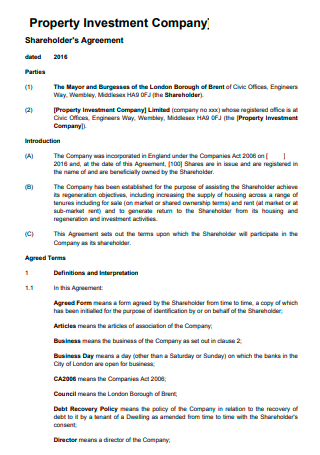
Property Investment Company Shareholders Agreement
download now -
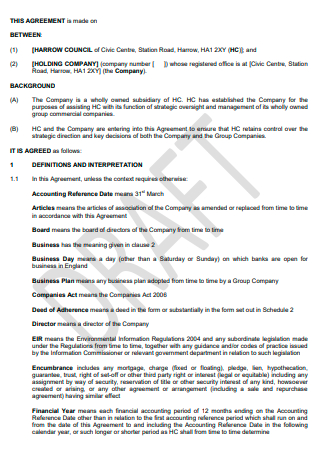
Draft Company Shareholders Agreement
download now -

Printable Company Shareholders Agreement
download now -
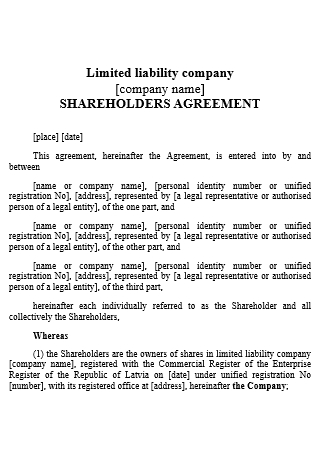
Company Shareholders Agreement in DOC
download now
FREE Company Shareholders Agreement s to Download
8+ Sample Company Shareholders Agreement
What Is a Company Shareholders Agreement?
What Are the Characteristics of a Company Shareholders’ Agreement?
What Is a Minority Shareholder?
What Are Some Information to Include in a Company Shareholder Agreement?
When to Use a Company Shareholders Agreement?
What Is the Importance of a Company Shareholder Agreement?
Elements in Terminating a Company Shareholders Agreement
How to Write a Company Shareholders Agreement
FAQs
What is the difference between a bylaw and a shareholders agreement?
Can a shareholder be forced out?
What if the shareholders have a disagreement or dispute?
What Is a Company Shareholders Agreement?
A company shareholders’ agreement is a contract between a company’s shareholders. It covers provisions governing the operation of the corporation and its shareholders’ relationship. A shareholders’ agreement, or stockholders’ agreement, is another term for a corporation shareholders’ agreement. It safeguards both the business entity and its shareholders’ investment. A company shareholder agreement is a contract between the shareholders of a certain business. Each of them may be included in the agreement. However, in some instances, the contract is entered into by a small number of shareholders. For instance, the agreement may be limited to shareholders of a particular class of stock.
Other templates are available on our website, and you can use them whenever you need them. They are as follows: business proposal, shareholder loan agreement, non-disclosure agreement, agreement checklist, construction bid forms, founders agreement template, domestic bidding contract, bid proposal, tenancy contract, disclosure agreement, and other similar templates are available. This post will not only provide you with templates but will also provide you with important information that you need to know in order to complete your template.
What Are the Characteristics of a Company Shareholders’ Agreement?
A shareholders’ agreement for a corporation is optional. The contents and provisions vary according to the circumstances. The specifics vary according to the entity’s type, the class of shares, and a variety of other criteria. Every shareholder agreement has certain fundamental components. Examples include the number of shares issued, the date of issuance, and the stockholders’ percentage ownership. Company Frequently, shareholder agreements govern the sale and transfer of shares to third parties. Additionally, they demonstrate how shares are treated in the event of a shareholder’s death. A pre-emption provision ensures that existing shareholders receive fresh shares prior to them being distributed to other potential shareholders.
A shareholders’ agreement also defines dividend payments and earnings distribution. It comprises provisions governing the business’s functioning, such as the frequency of board meetings and the appointment or resignation of directors. Additionally, it details the methods that will be used at various levels of decision-making. Numerous shareholder agreements also include anti-competition clauses and an adherence deed. Contrary to the competition and restrictive covenants, a shareholder is not permitted to compete with the company. For instance, they are prohibited from collaborating with a competitor firm located in the same geographic area. It is critical because it safeguards the business and the interests of other shareholders. A deed of adherence guarantees that new owners will comply with the terms of the pre-existing shareholders’ agreement.
What Is a Minority Shareholder?
Minority shareholders are people who own less than 50% of a company’s shares. Due to the fact that the majority of businesses are run by majority vote, minority shareholders typically have minimal authority over the organization. Minority shareholder protection laws have been enacted; nevertheless, the protection is limited due to the cost or practical difficulty of enforcing them. Minority shareholders may be protected by a shareholders’ agreement. One method is by provisions requiring unanimous consent for specific choices. As long as one shareholder objects, the decision will be vetoed, regardless of the shareholder’s ownership percentage in the corporation.
The unanimous approval requirement typically applies to decisions on the issuing of new shares or bonds, capital structure changes, the appointment or removal of directors, and significant business operations changes. While the requirement for unanimous approval benefits minority owners, it also has costs. It may sluggish decision-making and reduce efficiency. Another safeguard for minority shareholders is the “tag-along” provision. When someone makes an offer to purchase shares from a majority shareholder, this rule applies. The shareholder may not sell until and until the same offer is made to all other shareholders, including minority owners. It ensures the treatment of minority shareholders is equitable. They should be able to earn the same amount of money as the majority.
What Are Some Information to Include in a Company Shareholder Agreement?
A company shareholder agreement is a legally binding document that exists between the shareholders of a business. This document establishes the stockholders’ protections, benefits, and rights. You can use this agreement to safeguard shareholders’ investments, establish a secure connection among shareholders, and map out the company’s operations.
A company shareholder agreement form establishes certainty and clarity regarding your rights and obligations in the business. Additionally, it has a provision requiring that all choices be made by discussion and consensus. Although this document is not a “legal requirement,” it is strongly encouraged to create one in order to avoid future issues. Additionally, because this agreement is a private document, it is not required to be filed with the company’s records. However, each stakeholder in the corporation must retain a copy of the agreement in their personal files. This safeguards the confidentiality of the agreement’s terms and conditions.
When to Use a Company Shareholders Agreement?
It is highly recommended to execute the agreement upon the formation of the business and the issuance of its initial shares. You can use it as a proactive measure to ensure that you and your shareholders are on the same page regarding the firm. At this point, stockholders should have a similar understanding of what they receive and what they contribute to the business. If there are any disagreements between shareholders at this stage and they refuse to participate in the agreement, consider this a caution. You may possibly encounter troubles with such individuals in the future.
Occasionally, investors may postpone this arrangement, particularly if they wish to construct the company first. In such instances, return to the work of agreement creation when you have more time on your hands. Regardless of how many complications arise, it is critical to draft this agreement to safeguard your stockholders.
What Is the Importance of a Company Shareholder Agreement?
Important, practical, and particular rules are contained inside a shareholder agreement template, and these rules are directly tied to the firm and to its shareholders. The creation of such a document is extremely advantageous to all types of shareholders. Check out these statistics to see just how significant this document is:
1. For Minority Shareholders
A minority shareholder is a shareholder who holds less than 50% of the total number of shares of a corporation. This type of stakeholder, more often than not, does not have a voice or control over the company’s daily operations. As a result, control of the corporation is frequently concentrated in the hands of only one or two of the stockholders. In most cases, businesses run on the basis of majority choices. This occurs even if the articles of association contain measures that safeguard the interests of the minority. However, you have the option to overturn this decision through a special resolution passed by holders of at least 75% of the voting shares. Minority shareholders are afforded only the bare minimum of protection under the law. However, enforcing these can be quite expensive.
2. For Majority Shareholders
There are various instances in which a majority shareholder intends to sell his or her shares, but one or more of the minority owners is unwilling to agree to the transaction. The inclusion of a term in the shareholder’s agreement form that compels the shareholder to sell his or her shares is known as the “drag along with provision,” and it is critical in such a situation. This provision allows the majority shareholder to realize the value of his investment at a certain price and at a specific period, if and when he determines that it is suitable. It goes without saying that the purchase price, along with all of the other payments associated with the transaction, must be totally equitable to all of the other owners, including the minority shareholders. Besides that, a majority shareholder may desire to prohibit minority shareholders from disclosing sensitive information about the company to its competitors in the business. Additionally, they would not want these minority stockholders to form competing businesses. All of these should be included as clauses in the shareholder agreement.
Elements in Terminating a Company Shareholders Agreement
The majority of shareholder’s agreements can be canceled with the approval of all of the agreement’s shareholders. However, considerations for the type of the business, its time in the business cycle, and funding should be made. For instance, it may be advantageous for a growing business to have the shareholders’ agreement terminate at the corporation’s discretion. You, like any other party to a contract, have the option of terminating a shareholder agreement. This can be accomplished in three distinct ways:
How to Write a Company Shareholders Agreement
During the process of creating this specific legal document, you must ensure that it is customized to meet the needs of your firm. To put it another way, it requires specific measures to ensure that everyone working under it understands their responsibilities and what needs to be done in order for the company venture to be successful. Consequently, here is a list of the steps that must be taken in order to draft a proper shareholders agreement:
Step 1: Persons Involved in the Agreement Should Be Identified
A company shareholder agreement, like a rental agreement or a commission agreement, will need to identify all of the parties who are involved, including, of course, the shareholders who will sign it and the business as a whole. If you are starting a new business with a small number of owners, you might consider establishing a unanimous shareholder agreement. This way, you can ensure that all of the shareholders are bound by the terms of the agreement as a whole. If it is difficult to get every single one of them to sign the contract, it is preferable if you can get them all to agree on anything. Alternatively, if the primary owners are unable to sign the contract, minority shareholders should enter into a separate agreement with the firm that should define all of the rights and obligations of all of the parties involved.
Step 2: Describe the Organizational Structure of the Company
When you create an Attorney Agreement, you’re creating a structure that outlines how the attorney will provide services to the client. It’s similar to the previous example, except that you’re demonstrating the organization’s structure and how it runs. This is one of the most significant elements of the paper, and you should make sure to include it as soon as possible. The manner in which you should incorporate this into the agreement will be determined largely by the type of business in which you are all involved.
Step 3: The Rights of Shareholders Are Outlined in Detail
When you create a Settle Agreement or a Service Level Agreement, there will be a section that discusses what the service provider may do on his or her own initiative that does not conflict with the agreement. This section will be included in the agreement. Essentially the same thing happens in a shareholder agreement, which contains a part that describes the rights and obligations of the individual shareholders.
Step 4: The Corporation’s Legal Responsibility
The obligation of the service provider to ensure that he or she does what is required is stated in a statement that is included in the Maintenance Agreement that is created when the agreement is created. For a shareholder agreement, this is particularly relevant in the sense that it must describe the obligations of the shareholders in relation to the obligations of the corporation. You must make certain that the agreement is signed by a representative of the company as well as the shareholders.
Step 5: Description of the Circumstances Under Which Shares May be Transferred
In most cases, a shareholder agreement will include a section that discusses the restrictions on the transfer of shares, as well as the rights and obligations of each shareholder in turn. That does not rule out the possibility of the shareholders transferring their shares; rather, it means that certain conditions must be met before this can occur. This offers shareholders a certain amount of flexibility when it comes to disposing of their shares or making tax-planning decisions.
Step 6: Allow for the Purchase of Stock by the Corporation
It is possible for a shareholder agreement to contain a clause that allows the firm to repurchase a shareholder’s shares if the shareholder passes away or is otherwise no longer able to participate as an equity stakeholder in the business. This allows the corporation to keep the shares and potentially offer them for sale, as well as sell them to the other shareholders if they so want.
Make certain that you have all of them on hand, or you may find yourself in a legal bind in the near future. Also, keep in mind that if the big shareholders are unable to sign the document, you will need to turn to the minority owners and come up with a new agreement that they will be willing to sign.
FAQs
What is the difference between a bylaw and a shareholders agreement?
When used in conjunction with a company’s articles of incorporation, bylaws serve to serve as the legal foundation of the organization and to control its activities. However, a shareholder agreement is purely optional in this case.
Can a shareholder be forced out?
This is possible, but a Shareholder Agreement can mitigate the risk. For instance, if new shares are issued that dilute an existing shareholder’s interest, that shareholder may lose voting power.
What if the shareholders have a disagreement or dispute?
Numerous Shareholder Agreements feature a method requiring disputing parties to first document their disagreement in writing and then convene a meeting to resolve it.
In conclusion, a shareholders agreement is a flexible tool that may be used to help control the risks and growth associated with a firm. In order to provide a consistent framework for both shareholders and the business, it is important to strategically manage the many aspects of a shareholder agreement, such as governance measures and the transfer of interest. Excellent care must be exercised in the formulation of a shareholders agreement in order to guarantee that it is specifically adapted to the interests of all parties engaged in the corporation’s immediate and long-term destiny.
